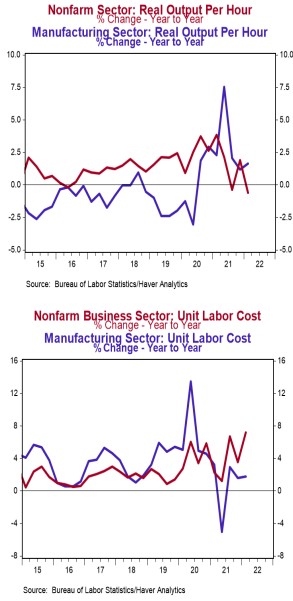- Nonfarm productivity (output per hour) declined 7.5% at an annual rate in the first quarter, coming in below the consensus expected decline of 5.3%. Nonfarm productivity is down 0.6% versus last year.
- Real (inflation-adjusted) compensation per hour in the nonfarm sector declined at a 5.5% annual rate in Q1 and is down 1.4% versus a year ago. Unit labor costs rose at a 11.6% annual rate in Q1 and are up 7.2% versus a year ago.
- In the manufacturing sector, productivity rose at a 0.7% annual rate in Q1. Real compensation per hour fell at a 5.9% annual rate in the manufacturing sector, while unit labor costs rose at a 2.1% annual rate.
Implications:
Productivity in the first quarter fell by the most since 1947, with labor costs surging and rising inflation remaining a key headwind for workers' purchasing power. The 7.5% annualized decline in productivity in Q1 came as output declined while hours worked rose, both combining to reduce output per hour. Productivity is down 0.6% from a year ago, but stands 2.6% above the level in the fourth quarter of 2019 pre-COVID. Although "real" (inflation-adjusted) compensation per hour fell at a 5.5% annualized rate in Q1, that doesn't mean workers are being paid less. In fact, wages have been rising, they just haven't been able to keep up with the high inflation. This is likely to remain an ongoing issue in the coming quarters, as inflation remains elevated while the rehiring of lower-paid workers puts downward pressure on the average amount paid per hour. On the manufacturing front, productivity rose at a 0.7% annualized rate as output rose quicker than hours. We are now well into a recovery, but expect hours and output will rise in the quarters ahead as the labor force continues to heal, supply-chain issues improve, and we work to get back to the level of output the U.S. would have seen had COVID never happened. Productivity growth historically can be very volatile from quarter to quarter, and the policy reactions due to the pandemic have only added to further volatility. It will take many more quarters or even years to clearly settle out how much the trend has changed in light of COVID and related policies, but the early read is that the growth potential of the economy is weaker than it was pre-COVID. In other news today, initial unemployment claims rose 19,000 last week to 200,000. Continuing claims fell 19,000 to 1.384 million. These figures are consistent with our forecast that nonfarm payrolls rose 375,000 in April.





